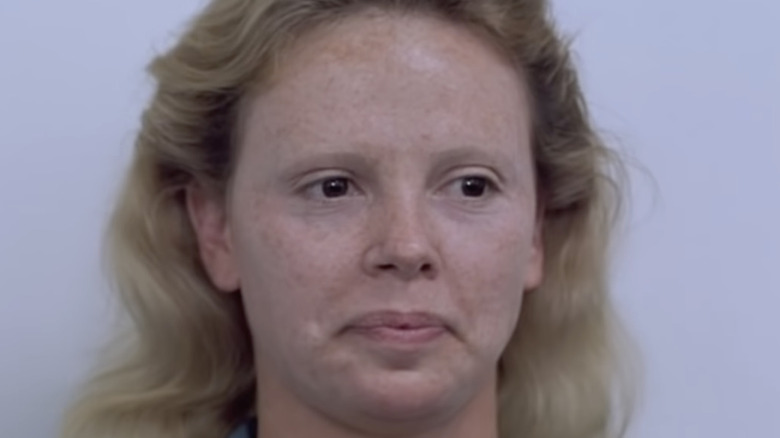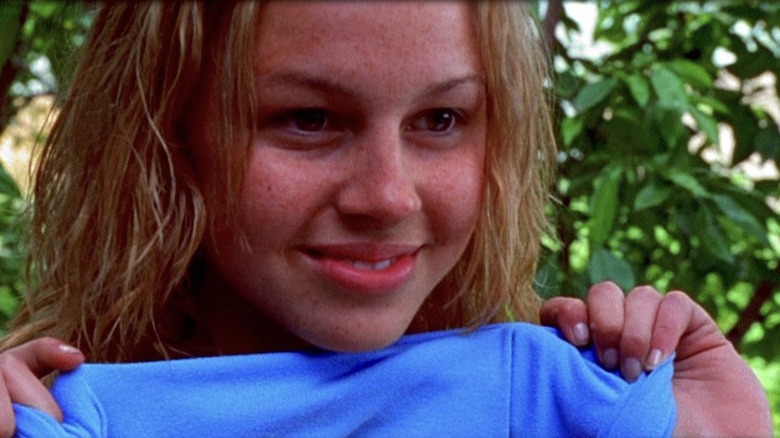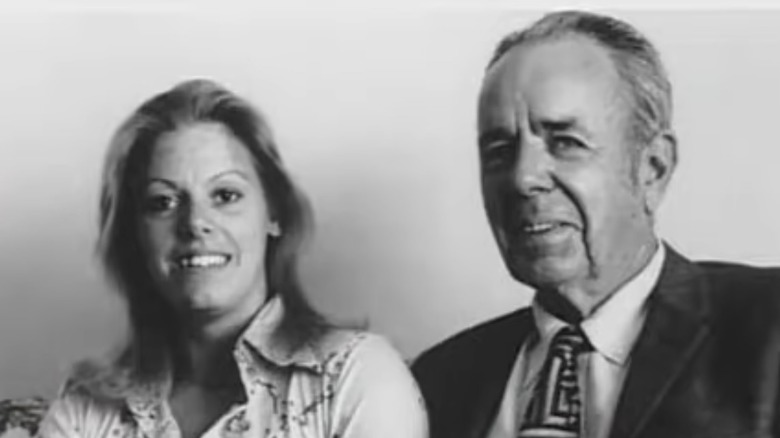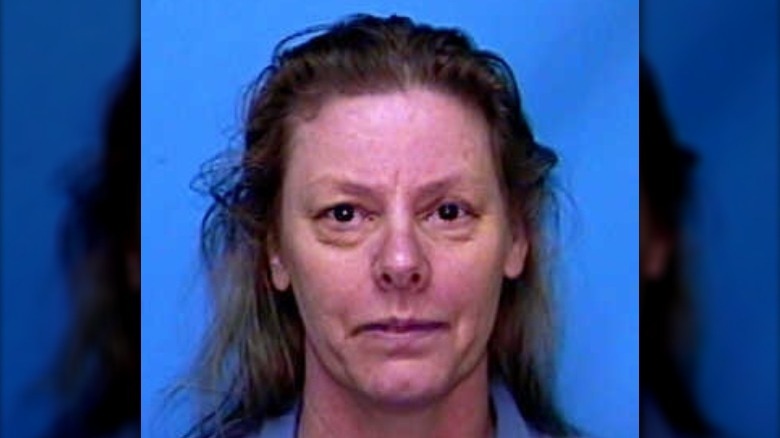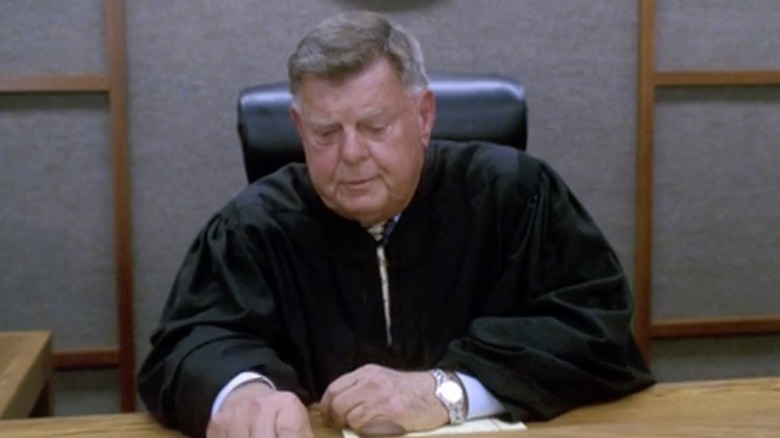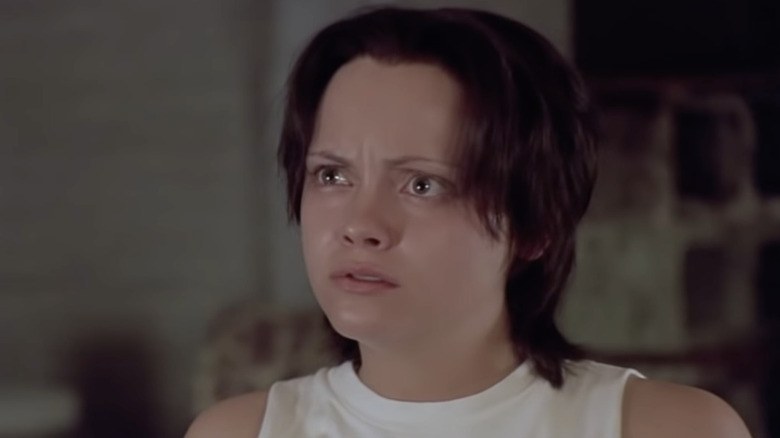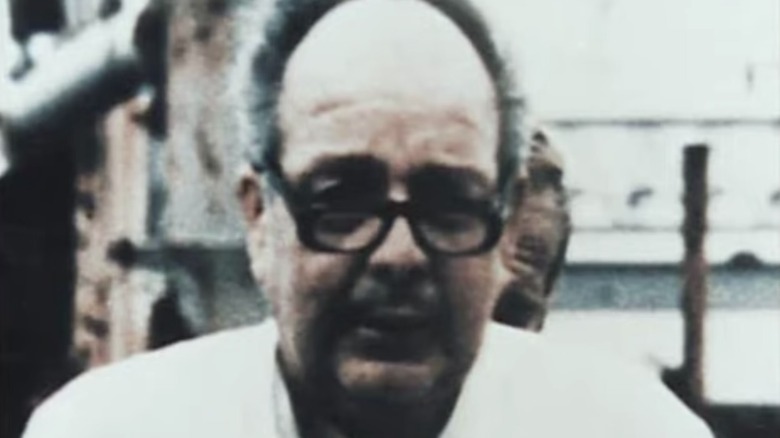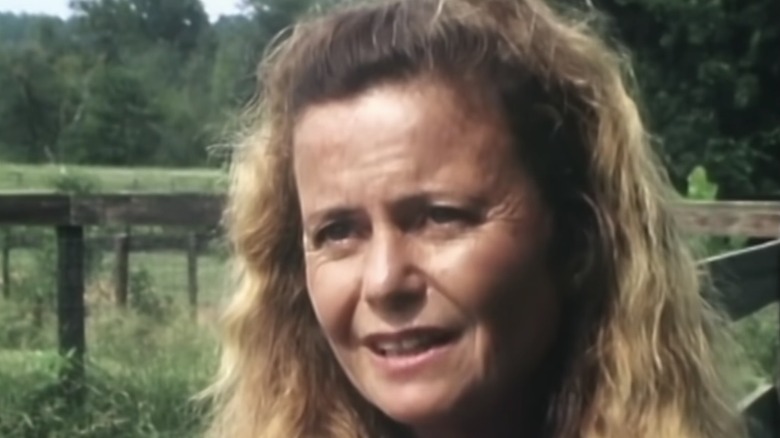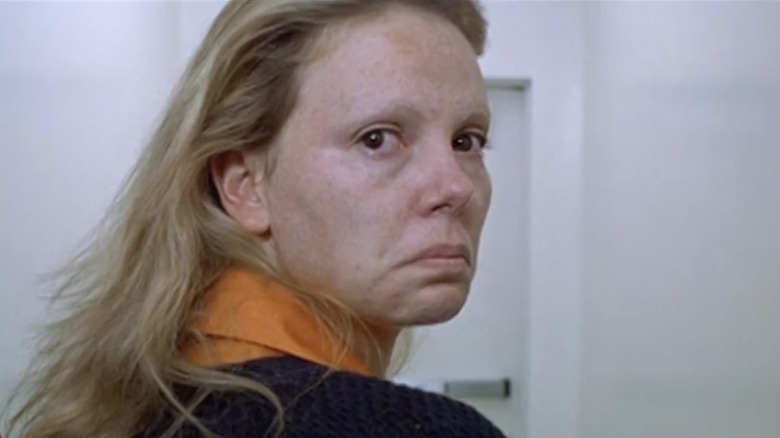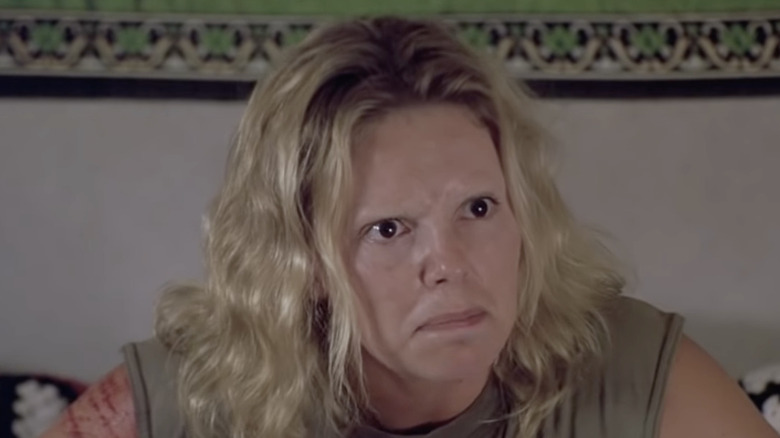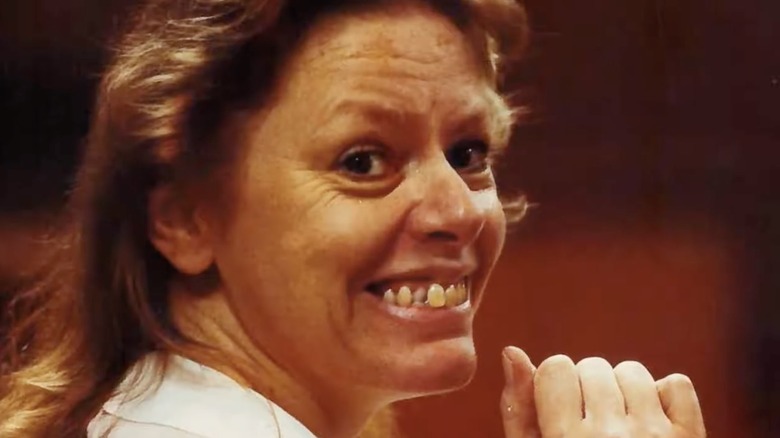Everything Monster Doesn't Tell You About The True Story
The film "Monster" stars Charlize Theron as Aileen Wuornos and starts with the disclaimer: "Based on a true story." However, any movie — even those inspired by reality — is fictionalized and dramatized to varying degrees in order to create a cohesive plot and clear message (which isn't always available in the chaos of real life).
"Monster" focuses on a year of Wuornos' life, when she killed seven men between 1989 and 1990, before being arrested in January 1991 (per The Sun Daily). Although the film is inspired by these real events, "Monster" focuses on Wuornos herself more than the victims of her crimes, who are shown just in relation to the events leading to their murders.
"Monster" centers around Wuornos, her relationship with Selby Ward (Christina Ricci), and the events leading up to her arrest and conviction, before ending with the statement that she was executed in 2002. In its scope on just a single year, the film leaves out important details of Wuornos' childhood and life before she became known as the "Damsel of Death," and it also excludes some of the strange events that transpired after her incarceration. Here are some things that "Monster" doesn't tell you about the true story of Aileen Wuornos.
Warning: spoilers included ahead, and note that the following article includes allegations of domestic abuse, child abuse, murder, and sexual assault.
Aileen Wuornos' childhood is even more tragic than depicted in the film
Although some of what transpired during Aileen Wuornos' childhood in Michigan is vaguely alluded to or casually referenced in the film, "Monster" minimizes the specifics. In the film, Aileen is shown as a child with bruises on her face in the opening sequence, which suggests she was physically abused. Later, Aileen reveals that her father and his friend assaulted her, which led to her getting pregnant as a teenager. She had the baby, which she gave up for adoption before getting kicked out of her home.
According to "Dead Ends: The Pursuit, Conviction, and Execution of Serial Killer Aileen Wuornos," by journalist Michael Reynolds, (who first broke Wuornos' story in 1990), Aileen's 16-year-old mother Diane Wuornos was struggling to take care of Aileen and her older brother, Keith Wuornos, so she left them to be raised by their grandparents.
In reality, the man who allegedly abused and molested Aileen as a child was her grandfather, as per Investigation Discovery, as Aileen never met her biological father, Leo Dale Pittman. Pittman was diagnosed with schizophrenia and by the time Aileen was born, he was already serving a life sentence for sex crimes against children, as per "Doctor Know's Guide to Serial Killers." When Aileen talked about her dad dying in prison in the film, she left out that he died by suicide in 1969.
As a kid, Aileen began trading sex for drugs and food from schoolmates, and she also began drinking. While it's much rarer for women to become serial killers, according to "The Role of Psychopathy and Sexuality in a Female Serial Killer" published in the Journal of Forensic Science, the intense trauma of Aileen's childhood and the resulting PTSD from it is partly what contributed to Aileen's becoming a murderer later.
If you or someone you know may be the victim of child abuse, please contact the Childhelp National Child Abuse Hotline at 1-800-4-A-Child (1-800-422-4453) or contact their live chat services.
If you or anyone you know has been a victim of sexual assault, help is available. Visit the Rape, Abuse & Incest National Network website or contact RAINN's National Helpline at 1-800-656-HOPE (4673).
Aileen Wuornos was briefly married
"Monster" takes place when Aileen Wuornos is in her 30s, and although there are some vague sketches about Wuornos' childhood in the film, there's nothing about her time as an adult before the year of her murder spree.
What the film doesn't reveal is that shortly after hitchhiking to Florida from Michigan when she was 20 years old, Wuornos briefly married an older, wealthier man in 1976. As The Cinemaholic reveals, Lewis Fell, aged 69, owned a yacht club, and despite the stability a marriage to a wealthy man could have given Wuornos, she continued to drink and fight in bars. Shortly after their nuptials, Fell took out a restraining order against Wuornos, alleging she beat him with his cane. After obtaining the restraining order, Fell had their marriage annulled just nine weeks after they wed.
If you or someone you know is dealing with domestic abuse, you can call the National Domestic Violence Hotline at 1−800−799−7233. You can also find more information, resources, and support at their website.
She had a brother who died of cancer
In "Monster," Aileen Wuornos tells Selby Ward that after being kicked out of her house as a teenager, she continued to help take care of her siblings. She says that she helped provide for them financially and made sure they had enough money for new clothes. This conversation implies Aileen was older than her siblings. In reality, she was the youngest: She had an older biological brother, Keith Wuornos, and her aunt and uncle (her mother's younger sister and brother) functioned more as Aileen's siblings in the Wuornos household, since they were all close in age, according to Michael Reynolds' "Dead Ends: The Pursuit, Conviction, and Execution of Serial Killer Aileen Wuornos."
Keith died from throat cancer in 1976. His death left her $10,000 in life insurance right around the same time her marriage to Lewis Fell was annulled (per The Sun Daily). Aileen squandered her inheritance on a new car that she soon wrecked. After her brother died, her life continued to spiral out of control, and her brushes with the law continued throughout the rest of the '70s and into the '80s, establishing a pattern of criminal behavior.
She was convicted of armed robbery before she started killing
Aileen Wuornos' violent behavior from 1989 to 1990 didn't come out of nowhere. She spent over a decade having brushes with the law. In 1974, Wuornos was arrested in Colorado for DUI, disorderly conduct, and firing a weapon from a moving car (per "Dead Ends," by Michael Reynolds). In 1981, she was arrested in Edgewater, Florida, for armed robbery of a convenience store. Almost a year later, she was finally sentenced to three years in a Florida prison for that crime, although she was released after only one year in 1983 (per Florida Department of Corrections).
Wuornos' brushes with the law continued. Less than a year after being released from prison, she was arrested for using fake checks. In 1985 she was a suspect in a gun theft. In 1986, she was arrested in Miami with a stolen car containing a revolver. Her charges included resisting arrest and obstruction of justice. In 1986, she was questioned after being accused of holding a man at gunpoint and demanding money, which suggests that Wuornos was on her way to killing, rather than just threatening and robbing her victims.
Her girlfriend's name was changed for the film
Selby Ward's (Christina Ricci) real-life counterpart is named Tyria Moore. While "Monster" depicts Ward as being out of work due to a broken arm, the real Moore was a cleaner at a hotel in Daytona Beach and moved in with Aileen Wuornos in 1986 (per The Sun Daily). In the film, their relationship starts right before Wuornos' first murder, but in reality, the women dated and lived together for a few years before Wuornos began killing in 1989, when she shot and killed Richard Mallory.
As depicted in the film, it was the car of Peter Siems, Wuornos' fourth victim, which led the police to Wuornos and Moore in connection with a string of murders of different men. Wuornos had stolen Siems' car after killing him, and the two women abandoned the car after getting into an accident on July 4, 1990.
In the film, Wuornos and Ward go their separate ways shortly after wrecking the car: Wuornos buys Ward a bus ticket home after learning authorities are looking for the two of them. However, the two women were actually on the run together for six months before parting ways and being apprehended separately in January 1991.
The police never recovered the body of Peter Siems
"Monster" shows Aileen Wuornos and Selby Ward separating and Ward getting the truth out of Wuornos about the murders while the police listen in, all of which is based on true events. According to Michael Reynolds' "Dead Ends," Wuornos and Tyria Moore were apprehended separately in January 1991 after fingerprints were found on an abandoned vehicle, which led to Moore cooperating with authorities. Moore elicited a confession from Wuornos during a series of phone conversations in exchange for immunity and later testified for the prosecution at the murder trial of Wuornos' first victim, Richard Mallory.
Although it was Peter Siems' car that led authorities to Wuornos in connection to the murders, the remains of Siems have never been found. Wuornos killed Siems in June 1990 and wrecked his car on July 4, leaving evidence she had carefully eradicated from her other victim's cars before dumping them. Siems' car was the clue that led to Wuornos being captured, charged, convicted, and executed (per The Office of the Clark County Prosecuting Attorney).
While in prison, Aileen Wuornos was legally adopted
Aileen Wuornos' life was marked by trauma and tragedy. Her life as an adult was spent spiraling out of control, drifting from town to town, and arrest to arrest. But Wuornos' life didn't stop being bizarre once she was convicted of murder and incarcerated in a Florida prison. The strange continued to court her.
Wuornos was legally adopted not once but twice in her lifetime. First, she and her brother were adopted by their grandparents, after their mother left them (per "Dead Ends," by Michale Reynolds). But Wuornos was adopted yet again as an adult, while she was in prison. Horse breeders and trainers Arlene and Robert Pralle petitioned the court and legally adopted Wuornos in 1991. Arleen told The Tampa Bay Times that God compelled her to reach out to adopt Wuornos, saying, "The reason we did it is we want her to know what it feels like to have a family that really cares about her."
According to The Tampa Bay Times, the adoption was not a ploy for the Pralles to make money from book or movie deals based on Wuornos' life. In fact, Wuornos herself wasn't in a position to do so, as Florida's "Son of Sam" law prevents felons from financially benefiting from their crimes through royalties on their stories. However, a felon's dependents can receive payments, but the nature of the Pralles' adoption would have made it difficult to say that they were dependents of Wuornos. Despite these protections and the fact that she consented to the adoption, Wuornos had a falling out with Arlene and Robert Pralle because she found out that they actually were making money from doing interviews about her (per Buffalo News).
She requested to be put to death
The film "Monster" ends with Aileen Wuornos being convicted and sentenced to death for the murder of Richard Mallory. She's led from the courtroom, while yelling at the judge. Before the credits roll, viewers learn she was executed by lethal injection in 2002. But the film left out some information about the road to Wuornos' execution. As many prisoners do, Wuornos appealed the murder conviction, but after over a decade on death row, she fired her lawyers and reconsidered her stance.
Wuornos wrote Florida's Supreme Court twice — once in April 2001 and again in June — requesting that they cancel her pending appeals and put her to death instead. According to CNN, Wuornos said, "I killed those men, robbed them as cold as ice. And I'd do it again, too. There's no chance in keeping me alive or anything, because I'd kill again. I have hate crawling through my system." She noted that it would be better to be executed and save taxpayers the money of keeping her alive.
Of course, some worried Wuornos didn't fully understand what she was asking the court to do. According to CNN, her response was, "I am so sick of hearing this 'she's crazy' stuff. I've been evaluated so many times. I'm competent, sane, and I'm trying to tell the truth, and I'll take a polygraph on every single word on those pages." A panel of psychiatrists evaluated Wuornos again and agreed, deeming her sane and fit to be executed.
The film didn't share her last meal or words
Aileen Wuornos met her end on the morning of October 9, 2002, when she died of lethal injection in a Florida prison, after requesting only a cup of black coffee as her last meal (per Investigation Discovery). "Monster" ends after Wuornos' first conviction, so it doesn't show her death, nor does it include her last words. As reported by CNN, Wuornos' last words were, "I'd just like to say I'm sailing with the Rock and I'll be back like 'Independence Day' with Jesus, June 6, like the movie, big mothership and all. I'll be back."
These final words combine religious and science fiction imagery and may be a reflection of Wuornos' mental state and illness. Mental evaluations conducted on Wuornos showed she was unstable but competent to stand trial, and later competent to be executed by the state of Florida (per CNN). Wuornos was evaluated multiple times after being arrested and convicted of murder. Wade C. Meyers, Erik Gooch, and J. Reid Meloy argue in "The Role of Psychopathy and Sexuality in a Female Serial Killer" that there is evidence she met the criteria for being diagnosed with borderline personality disorder and antisocial personality disorder.
Producers of the film never contacted her victims' families
Some have criticized "Monster" for portraying Aileen Wuornos as a victim, who killed in self-defense, rather than being shown as an opportunistic killer. According to ABC News, Wuornos' depiction in the film as a victim of physical and sexual abuse and societal failings has upset the families of the men that Wuornos killed. ABC News reports that producers of the film never reached out to the victims' families, as "Monster" producer Brad Wyman claimed they didn't want to "unearth more tragedy in their lives."
Charlize Theron, who was also a producer on the project, never consulted with the prosecutor, John Tanner, which makes some think her representation of Wuornos was biased. Tanner told ABC News, "Anyone that sees that film is left with the impression that — at least some of the men that were murdered deserved to die and that she was acting in self-defense. It's a total lie." This perspective seems like an oversimplification of the film, as it overlooks Theron's nuanced portrayal of Wuornos as a dangerous and volatile woman, who was also damaged and conflicted.
Sue Russell, who wrote the book "Lethal Intent" about Wuornos' life and crimes, wrote an article for The Washington Post addressing what she saw as the whitewashing of Wuornos' crimes by Hollywood. Russell acknowledges that despite Wuornos changing her claims of self-defense repeatedly over the years, her first victim Richard Mallory was found clothed and was shot from behind. Although Russell confirmed that after Wuornos was convicted, it was revealed that Mallory had been charged with a sexual assault when he was 19, he didn't have further charges after that.
Aileen Wuornos was not the first female serial killer as suggested by the film
Although the media dubbed Aileen Wuornos as America's "first female serial killer," and the film "Monster" continued with this approach, Wuornos was not the first woman to kill multiple victims over time. The FBI adopted the term serial killer in the 1970s due to the work of Robert Ressler, who was a pioneer of criminal profiling and came up with the term "serial killer" (per NPR).
As reported by News Channel 8, Wuornos was the first female serial killer to be profiled by the FBI, but the idea of her being America's first female serial killer is erroneous. Genene Jones, a Texas nurse, was jailed in the '80s for killing an infant and giving an overdose to another baby. Jones was long suspected of killing many more infants at the hospital she worked, but it wasn't until 2017 that she was charged with five more deaths (per USA Today). Although Jones' crimes pre-date Wuornos, it was Wuornos who garnered the title of "America's first female serial killer" because of the gruesome nature of the killings and the media sensationalizing the crimes.
